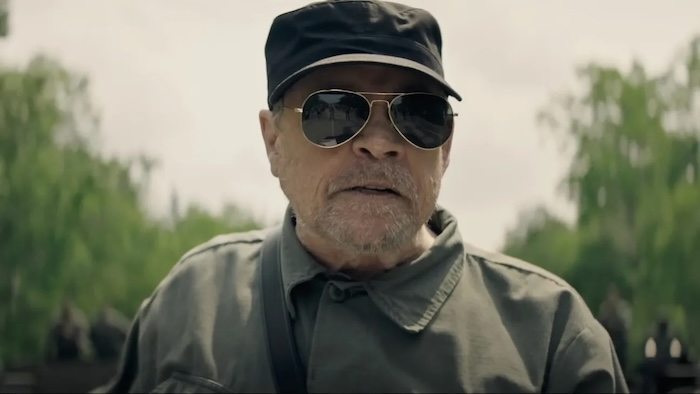By Dustin Rowles | Film | September 12, 2025

There are spoilers for the book and the movie. Obviously.
I read Stephen King’s The Long Walk about a week before watching the movie, and it’s interesting because they’re very similar, yet neither detracts from the other. They’re both great in the same ways but also different. A novel can capture things a movie can’t, and vice versa, but Francis Lawrence probably delivered about as strong an adaptation as possible — one that makes the central characters more likable and the ending slightly less bleak.
What Francis Lawrence does not do, working from a JT Mollner screenplay, is change the premise. The movie opens with some exposition explaining what the Long Walk is — material that in the novel emerges through conversations about three-quarters of the way through. But it’s a movie: a little spoon-feeding is expected.
The premise: 100 teenagers in the novel (50 in the movie) walk until they can’t anymore, at which point they’re shot. The last one standing wins. A minor change is the pace requirement. In the novel, it’s 4 mph. In the movie, it’s a more realistic 3 mph (since 4 mph is almost a jog). Both are set in Maine, though the novel uses real geography. The movie, shot in Canada, only mentions Freeport, though it looks nothing like the real Freeport (no giant L.L. Bean Boot, for starters).
In the novel, the Major is more of a looming presence. Played by Mark Hamill in the film, he’s far more visible. If you cast Mark Hamill, you don’t let him go to waste.
The characters carry over, but their personalities vary. The lead, Ray Garraty (played by Cooper Hoffman), is more flawed in the book. He has a girlfriend with whom he has a fraught relationship (in flashbacks, he uses the Long Walk to manipulate her into sex). There’s no girlfriend in the movie. Instead, the film gives Ray an inspirational father who’s executed by the Major for refusing to bend the knee. In the novel, the father is alive but cruel. In both versions, Ray has a tender relationship with his mother (played by Judy Greer). In the book, she and the girlfriend are in the crowd in Freeport to see Ray pass. In the movie, there’s no crowd, just his mother, relieved but fearful.
McVries is also altered. In the novel he’s bitter and sardonic; in the film, he’s the heart and soul, providing its emotional core. Ray and McVries bond in both versions, but it feels more brotherly on screen.
The ending diverges most. In the book, Arthur Baker is a minor character, but in the movie he’s expanded (played by Tut Nyuot) and essentially given McVries’s fate from the novel: he fades at the end and dies with dignity.
Other major characters — Stebbins (Garrett Wareing), the illegitimate son of the Major; Barkovitch (Charlie Plummer), the bully who softens before self-destructing; and Hank Olson (Ben Wang) — meet similar fates. (Though in the novel, the brash walker is named Collie Parker; Hank Olson exists too, but he’s minor.)
The biggest shift comes at the finish. In the book, Ray and McVries are the last two. McVries finally gives in, shakes Ray’s hand, and stops. Ray wins but is delirious, hallucinating, and unable to process his victory. It’s an ambiguous, brutally dark ending: perhaps he dies moments later, perhaps not, but either way, the victory, after 300 miles and 99 deaths, is meaningless and hollow.
In the movie, when McVries falters, Ray won’t let him quit. He falls back with him, urging him to keep going. McVries does, but Ray stays behind and is shot. McVries wins, and as his prize demands a gun. The Major scoffs, certain he won’t use it — why throw away the riches that come with winning? But McVries shoots him dead, honoring Ray’s father. Then McVries walks away as the credits roll.
The victory is less hollow, though it’s hard to believe another man won’t simply step into the Major’s place and the Long Walk continue, same as it ever was.